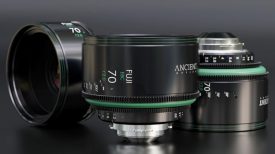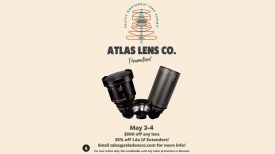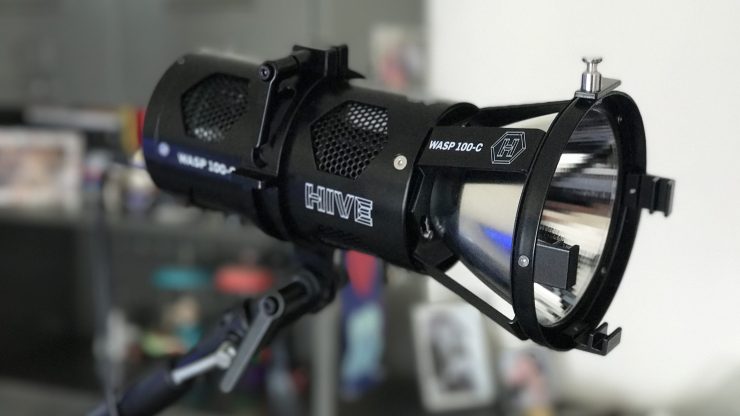
Hive lighting are well-known for their plasma lights, but the new Hive Wasp 100-C is a step in a different direction. The Wasp 100-C is based around five-colour LED technology and it has a host of tricks up its sleeve for creating unique looks.
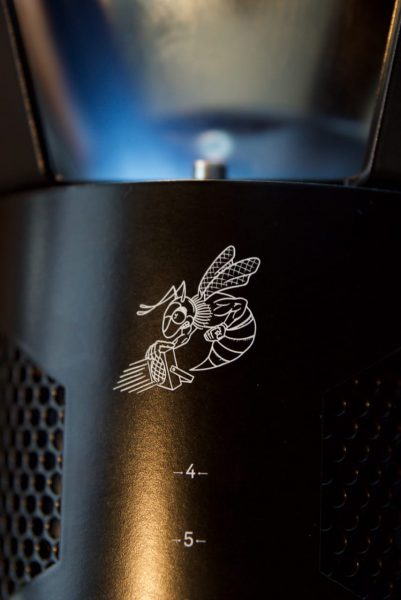
We reported on the Wasp 100-C at Cinegear and we were so impressed by it we thought it warranted an even closer look. If you want to see a quick introduction to the lamp you can watch our interview from Cinegear below.
Built tough
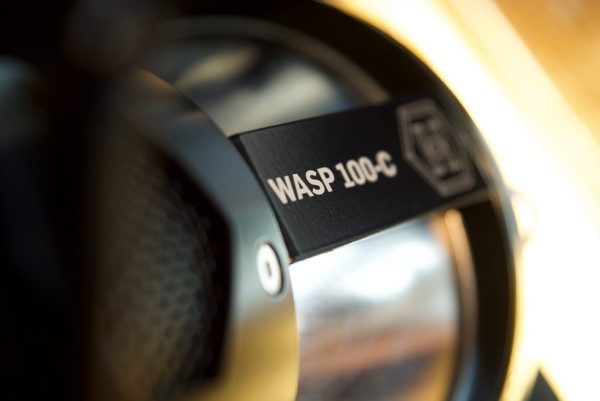
The first thing that strikes you about the Wasp 100-C is just how well made it is. The company certainly hasn’t cut any corners with the materials used and the quality of the finish. The all-metal housing looks to be very strong considering the weight of the light is just 1.7kg (3.74lb).
The physical size of the light is also a big advantage if you do a lot of travelling. It’s just 30cm (11.8″) long and 14cm (5.5″) at its widest point. This makes it easy to pack into smaller bags where a lot of other lights couldn’t fit.
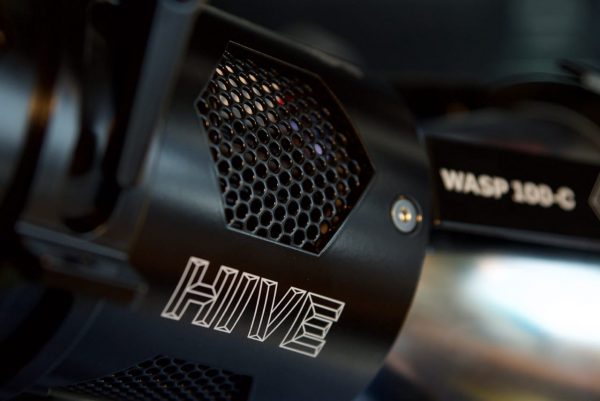
The light has large vents all over the housing and it also uses a fan to keep the Wasp cool. There is some fan noise, and while it is minimal, you would definitely hear it in very quiet conditions. Unlike some other COB (chip on board) fixtures I have tested, the Wasp remains really cool, even after extended periods of use.
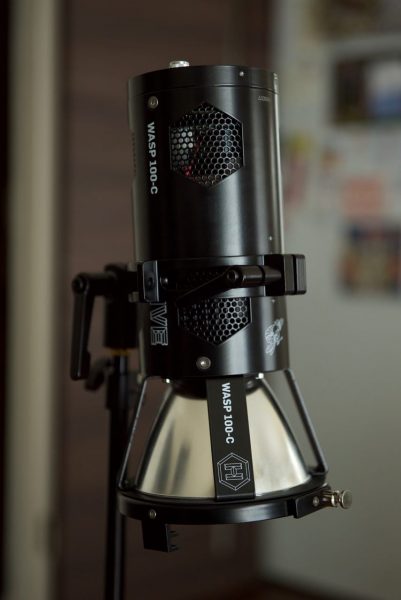
Another nice aspect of the light is that it features both vertical and horizontal adjustment. In a clever design move Hive have made a bracket that goes around the fixture so you can slide the mounting point forwards or backwards. This gives the light a full range of movement so you can point it directly up or down depending on your needs. This might sound like a small thing, but it is incredibly useful when you need to adjust the position of the light.
Low power draw
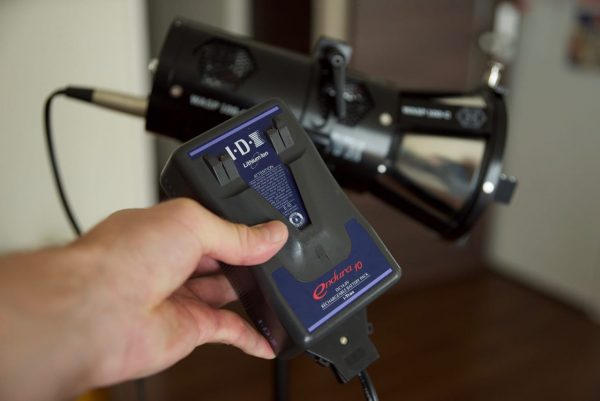
At its maximum brightness the Wasp only draws 80W, which makes it very easy to run the light off a camera battery. You do have to use an optional D-tap to four-pin XLR adapter to do this, or in my case I just used a four-pin XLR to three-pin connector that plugs directly into the bottom of V-mount batteries. The light will work using a 90Wh battery, however Hive recommend that you use a battery with at least a 100Wh rating that has a minimum 10 Amp-hour fuse. The ability to run this light remotely in the field off readily available camera batteries is a big deal for me.
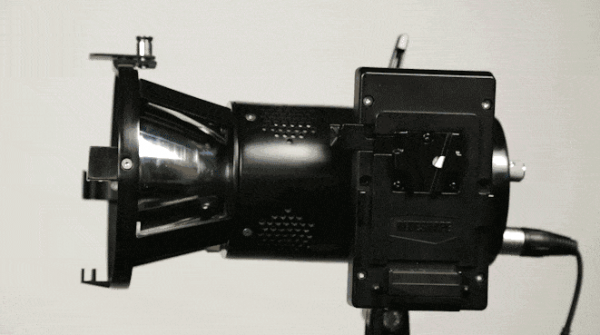
Hive also makes an optional V-mount or Anton Bauer battery plate that attaches onto the side of the fixture.
The light also comes with a nice long power cable that reaches the floor easily when the fixture is placed up high on a light stand. This is something that some manufacturers overlook, and I have tested numerous lights where the power cable doesn’t even reach the floor when it is on a light stand at normal height.
Perfect S.H.O.T. – all the colours of the rainbow
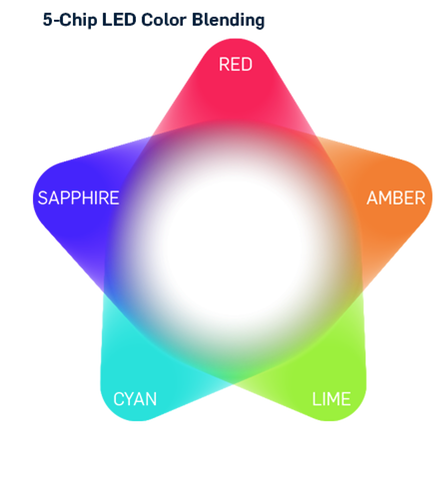
Hive claim the Wasp 100-C offers the best of RGB and bi-colour style LED fixtures, by using five-colour LEDs to make up white light. This results in fully saturated colours – reds are truly red, greens truly green. You also have fine control over the colours, down to increments of 1°K. You can also control the saturation and hue. The aim is to provide the flexibility of a gel pack without the need to actually carry a gel pack around with you.
Hive’s ‘Perfect S.H.O.T.’ system lets you control these four properties:
• Saturation (denoted by “S” on the display)
• Hue (denoted by “H” on the display)
• Output or Dimming (denoted by “D” on the display)
• Color Temperature (denoted by “K” for degrees in Kelvin when in local mode, or by “C” when in DMX mode.)
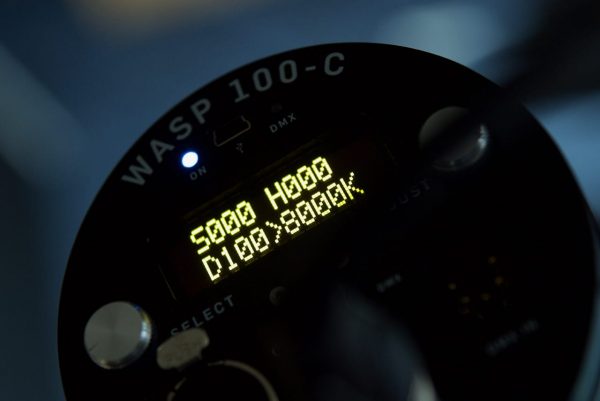
The light’s colour temperatures can be set from 1,650K – 8,000K with an intensity claimed to be roughly comparable to a 650W tungsten fixture (depending on what Kelvin temperature it is set at).
Control, control, control
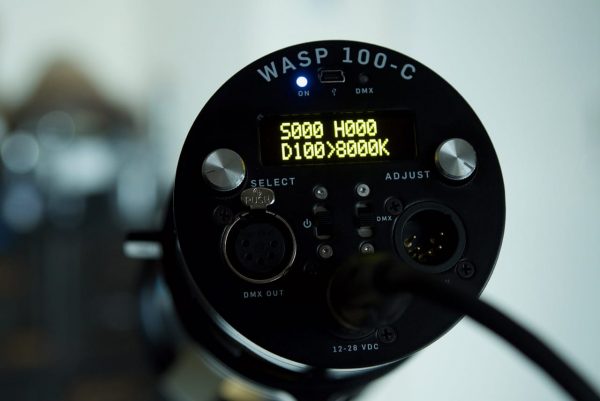
The Wasp 100-C can be controlled directly on the unit itself, via DMX, or through a very smart and easy to use app via bluetooth.
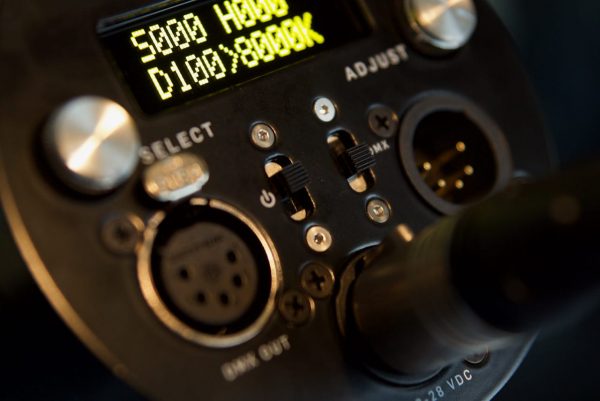
On the back of the Wasp you have a simple on/off switch, another switch to turn DMX on or off and two dials for selecting and adjusting the light.
The light takes about three seconds to come on once you flick the switch and then you will see an easy to read LCD screen. You can then use the select button to move between the saturation, hue, dimming, and colour temperature settings. By twisting the adjust dial you can make larger adjustments, but when you press down on the dial and twist it you can make much finer adjustments.
These physical controls are really easy to use and well thought out. I didn’t have to consult the manual once, which is the sign of a well designed product.
Bluetooth baby!

The light has bluetooth built in, and Hive has a free iOS app that gives you control over your Wasp from your iPhone or iPad. All you have to do is turn bluetooth on and connect to the light. You then open the Hive SHOT app and select your fixture. You are then greeted by a very simple and easy to use control screen.
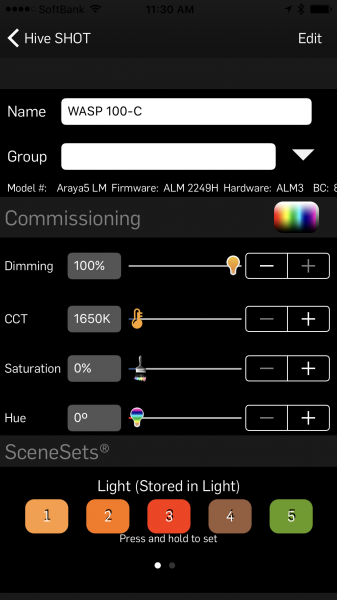
You can change every parameter of the light right from within the app – the dimming, the saturation, the hue, and the color temperature. By either sliding an icon on the screen, or pressing the + or – buttons you can make your adjustments.
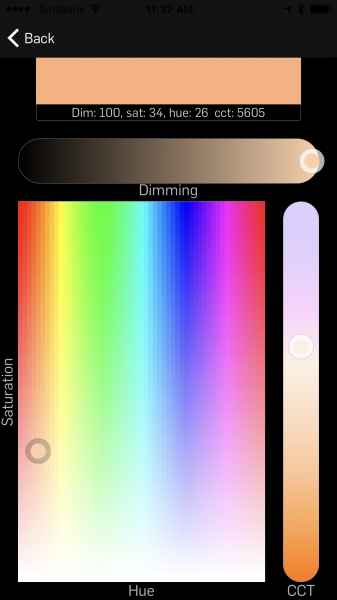
There is also another screen you can go to where it gives you a visual color indicator so you can select an exact saturation/hue position. You can also adjust the dimming as well as the color temperature from the same screen. This allows the end user to create really interesting color looks by making adjustments to all four parameters.
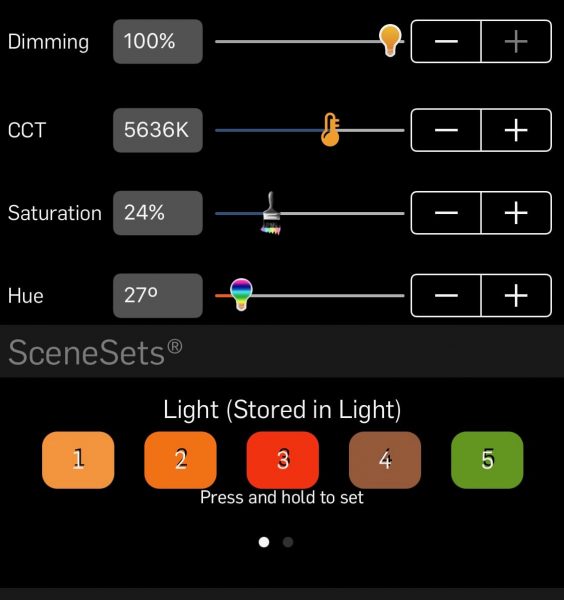
The app also enables you to pre-save settings that you can then just recall at the touch of a button. This is very handy as you can set the light up in a way that best works for your camera and then have the peace of mind that you can re-use that same setting anytime you need to.
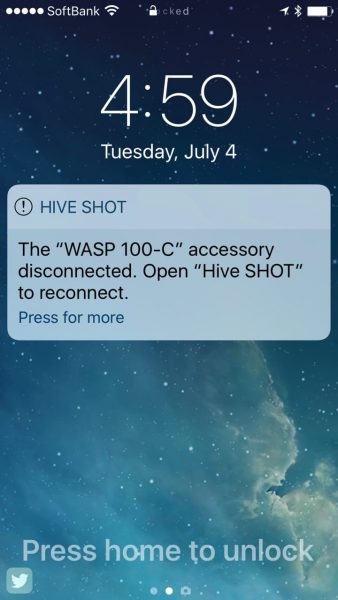
Another handy feature on the app is that if you get disconnected from the light a warning message comes up on your phone or tablet and you can re-connect quickly.
DMX
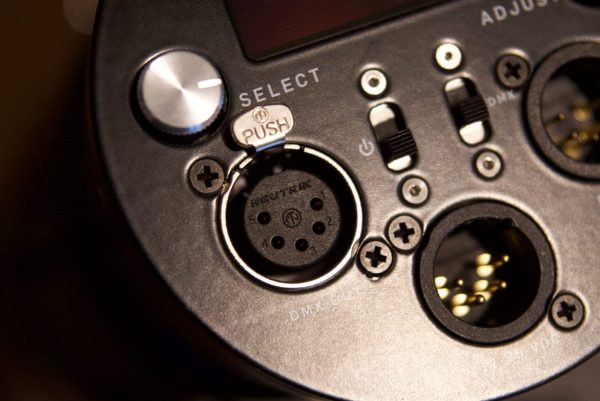
The light has a five-pin DMX in and out on the back panel. You can use the DMX-in socket to connect the Wasp to a DMX board via a five-pin XLR cable. You can use the DMX out socket to connect the Wasp to another light via a five-pin XLR cable when using one DMX board to control multiple lights. The light uses the DMX512 standard to allow multiple lights to be daisy chained together.
Firmware upgradable
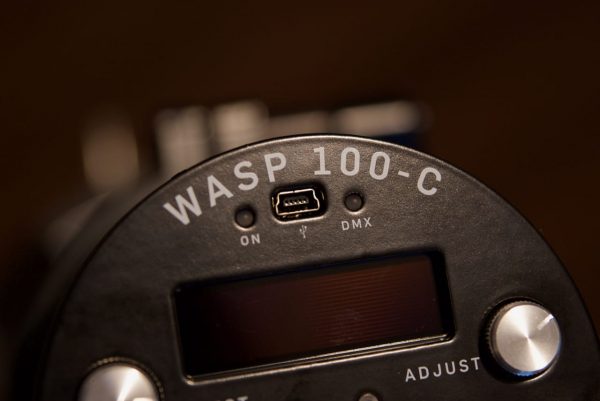
The light also has a mini USB port so you can update the firmware in the future.
Beam me up Scotty
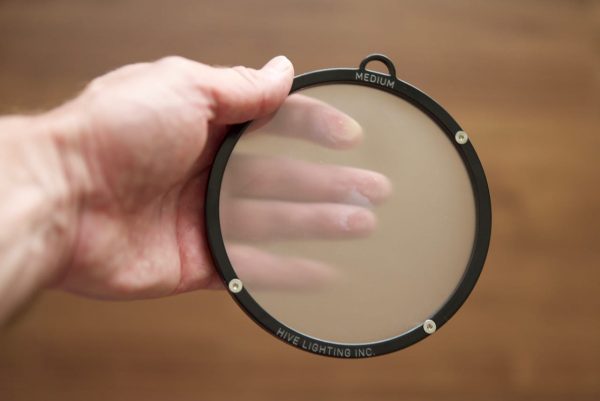
The Wasp 100-C is a par-style light that comes with a 22° reflector as standard and three spreading lenses that can take the beam spread up to an 80° flood. What’s more interesting though is that the mount on the front of the light is compatible with all sorts of pro photo gear: everything from Chimera and Elinchrome softboxes to Hive’s own 10° long-throw reflector and mini source four adapter for even tighter beam control.
Barn doors
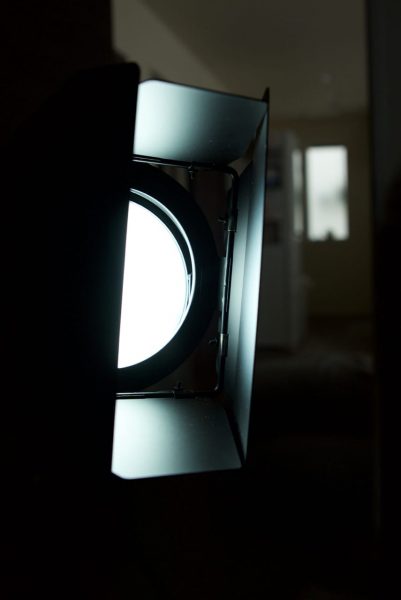
The light comes with a set of rotating barn doors that sit securely on the front of the fixture. These are well made and robust and give you the ability to further help direct and shape the light.
Photometrics
Hive claim a CRI of 98 , which sounded a little high for a 1600-8000K colour adjustable fixture. I used a Sekonic C-700 to test the lights output and colour accuracy at various Kelvin temperatures. All tests were conducted in a controlled environment at a distance of 1m (3.28ft). CRI results only tell a small part of the story and you should never just take them into account when judging a light.
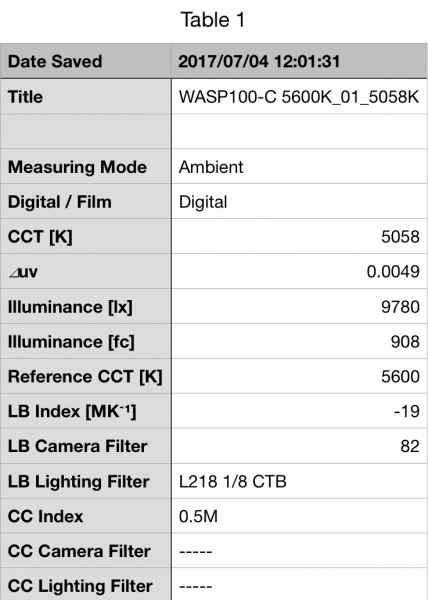
Above you can see the output of the light when I tested it at 5600K with the standard 22° reflector. The light recorded an output of 9780lx and a kelvin temperature of 5058K. This output was very impressive from a light this size. To put this figure in perspective the Aperture COB 120d (5600K) puts out 4880lx, but that light does have a much wider beam angle than the Wasp 100-C. Unfortunately the 5085K kelvin temperature I recorded was quite a way off replicating a 5600K source.
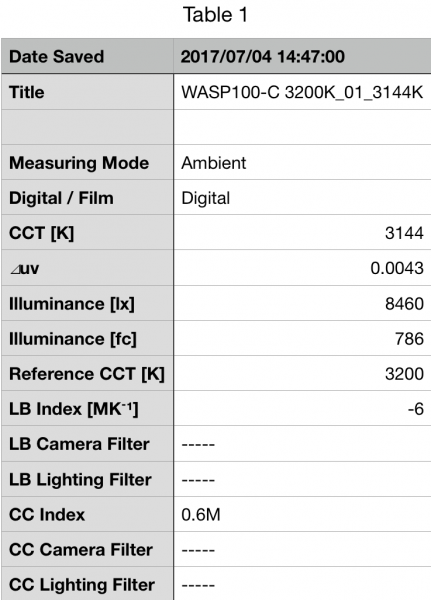
Above you can see the output of the light when I tested it at 3200K with the standard 22° reflector. The light recorded an output of 8460lx and a Kelvin temperature of 3144K. The output was less than at 5600K, but still very respectable and not a massive fall off. The Kelvin temperature I recorded was very close to accurately replicating a 3200K source.
I also tested the light at a variety of other colour temperatures and here is what I got:
1650K – 3260lx 1679K
3200K – 8460lx 3144K
5600K – 9780lx 5058K
6600K – 9510lx 5881K
8000K – 8100lx 6686K
As you can see the output of the light remains pretty good from 5600K up to 8000K, but as you start going down from 5600K to 1650K it starts falling off pretty dramatically. However, the light was a lot more Kelvin temperature accurate at 3200K and below than it was at 5600K and above.
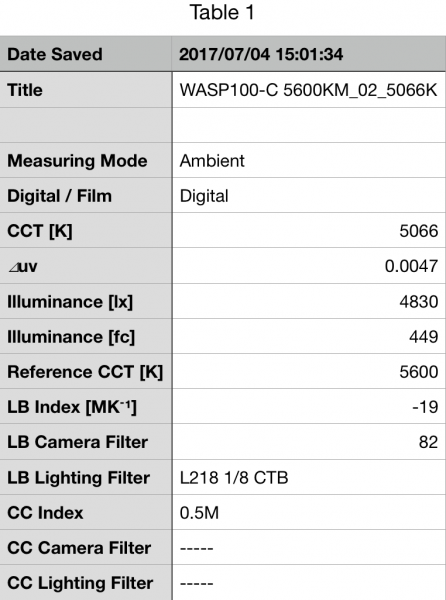
I also tested the light with the Medium interchangeable HDP lens at 5600K to see how much it affected the output and if the Kelvin temperature changed. As you can see the light loses roughly half its output when using the Medium HDP lens. The Kelvin temperature was almost identical to that of the light when not using a HDP lens.
Colour rendition
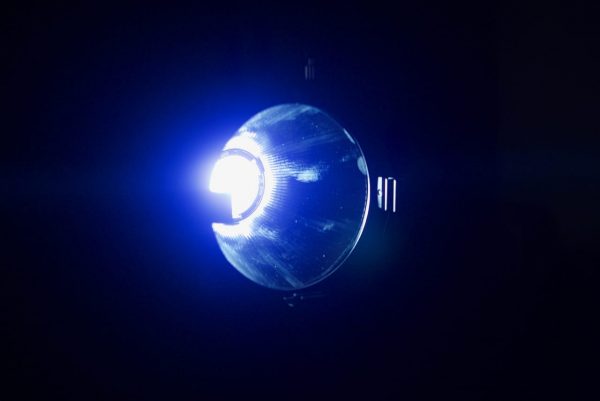
The output of the Wasp was good, but could it live up to the high CRI numbers that Hive Lighting claims? Usually LED lights that can produce such a wide range of Kelvin colour temperatures do so at the expense of colour accuracy.
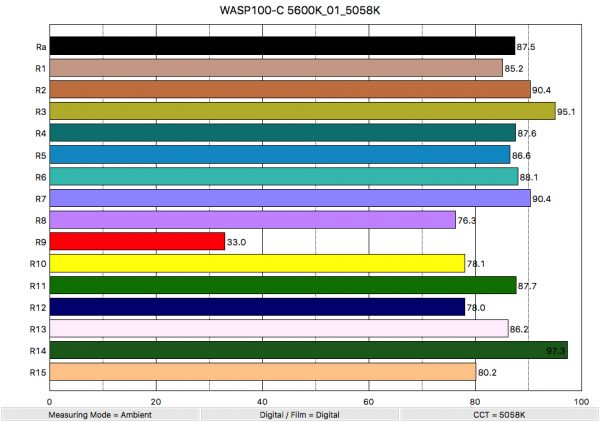
Above you can see the light’s colour rendering scores when it was set at 5600K. The light recorded a average CRI (R1-R8) of 87.5, and an extended CRI (R1-R15) of 82.68. For the all important skin tone rendition it recorded 33.0 for R9 (red), 86.2 for R13 (closest to white skin tones), and 80.2 for R15 (closest to asian skin tones). These numbers are so so, and the 33.0 for R9 (red) was one of the lowest readings for R9 that I have ever recorded. The average CRI (R1-R8) of 87.5 was a far cry below the claimed 98 that Hive states.
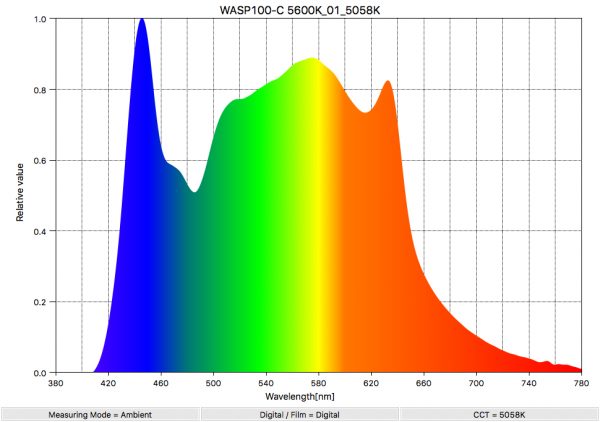
Above is the Spectral Distribution chart of the Wasp 100-C when it was set at 5600K.
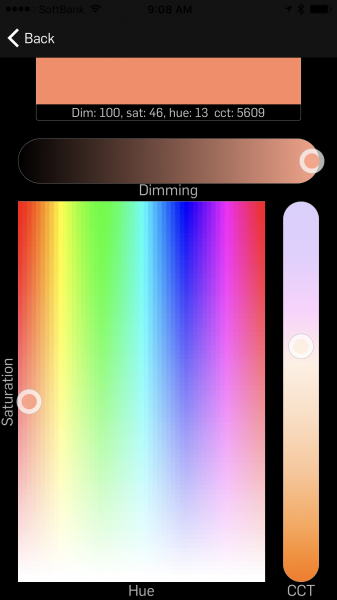
As the Wasp 100-C has saturation and hue adjustment I decided to to play around with the settings to see if I could get better results. As the R9 (red) score was just 33 I decided to add more saturation (46%) and move the hue setting towards red (13%) to see what would happen.
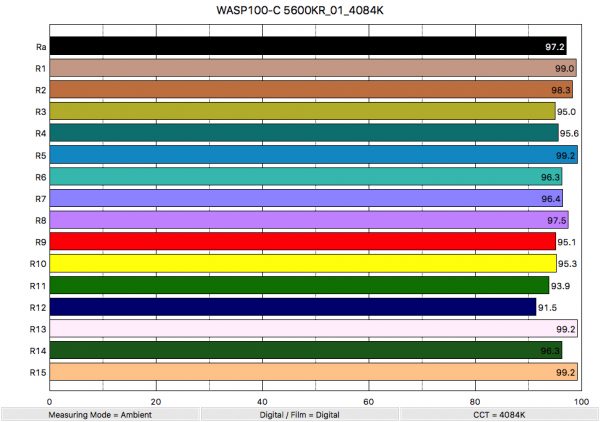
Above you can see that the scores improved dramatically, and the reading for R9 (red) improved from 33 up to 95.1. The average CRI reading jumped from 87.5 to 97.2, and the extended CRI rose from 82.68 to 96.52. The downside of adding hue and saturation is that you are altering the kelvin temperature and output of the light. Instead of reading 5600K the Wasp 100-C now gave me a reading of 4084K, and the output fell from 9780lx to 6010lx. At the end of the day figures are just figures and setting the light up like this may well appease the Sekonic, but it doesn’t necessarily mean the light source will look nice.
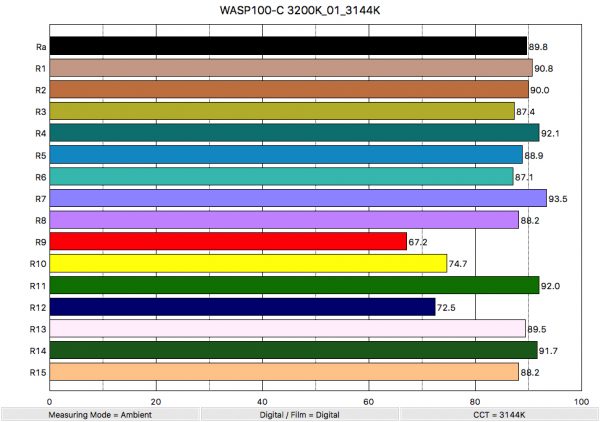
Above you can see the light’s colour rendering scores when it was set at 3200K. The light recorded a average CRI (R1-R8) of 89.8, and an extended CRI (R1-R15) of 86.25. For the all important skin tone rendition it recorded 67.2 for R9 (red), 89.5 for R13 (closest to white skin tones), and 88.2 for R15 (closest to asian skin tones). These numbers are OK, but the 67.2 for R9 (red) was a very low score. The average CRI (R1-R8) of 89.8, while still good, was a far cry below the claimed 98 that Hive states. Again, you can play around with the hue and saturation controls to get better readings.
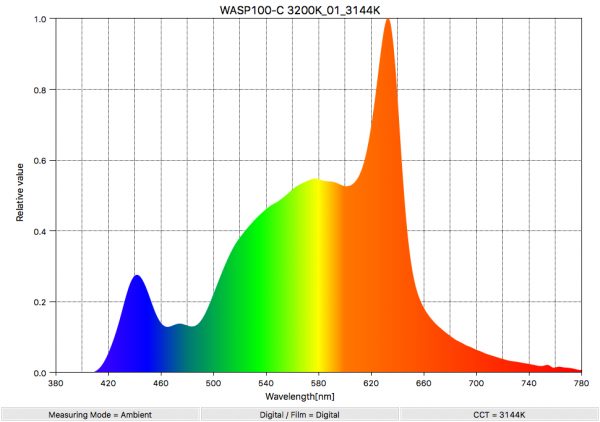
The spectral distribution chart above shows significant gaps in the light’s ability to reproduce a full spectrum.
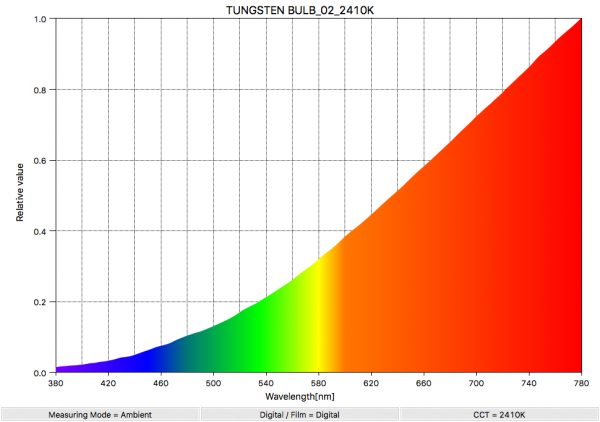
As a comparison, above is the spectral distribution for a typical tungsten bulb.
I tested the colour rendition of the light at various other Kelvin temperature settings:
1650K – average CRI (R1-R8) 93.0 extended CRI (R1-R15) 90.66
3200K – average CRI (R1-R8) 89.8 extended CRI (R1-R15) 86.25
5600K – average CRI (R1-R8) 87.5 extended CRI (R1-R15) 82.68
6600K – average CRI (R1-R8) 87.1 extended CRI (R1-R15) 81.90
8000K – average CRI (R1-R8) 91.2 extended CRI (R1-R15) 87.70
But does this all matter?
CRI is not the best measuring tool for LED lights, but it does give us a reference from which we can compare it to other lights. As I mentioned earlier, the nice thing about the Wasp 100-C is because you can adjust the saturation and hue as well as the colour temperature, you don’t really need to worry too much about CRI scores. All cameras respond differently to lights and no two cameras tend to give you the exact same look. By being able to adjust the Wasp 100-C you can tune it to create whatever looks best for that particular camera. This is key, because unlike most other LED lights where you can only adjust the Kelvin temperature, the Wasp lets you manipulate the light to best suit the look you are after.
Real world usability
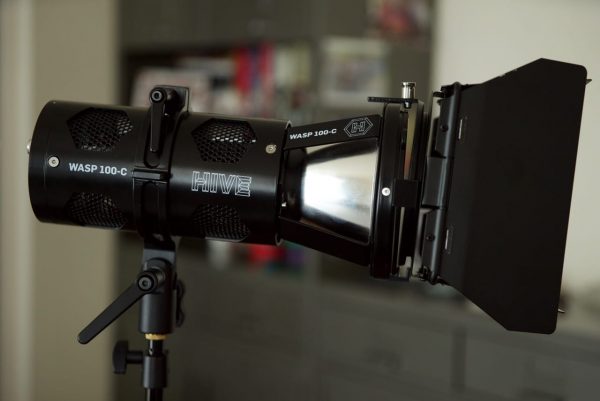
Despite the colour rendering scores being lower than those claimed by Hive when the light’s hue and saturation controls are set to 0%, the numbers as always only tell part of the story. For me the best thing about this light is its versatility. It really is a jack of all trades light that can be used in a variety of ways.
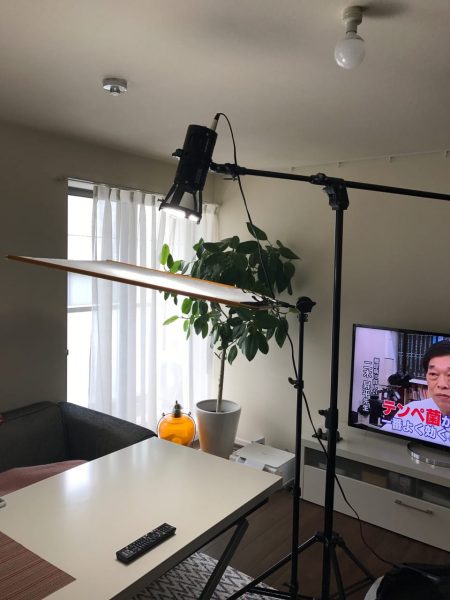
You can use it for a key light for an interview, a bounce light, a direct hard source, a diffused direct or in direct source, a SFX light, a green screen light, or just about anything else you can think of.
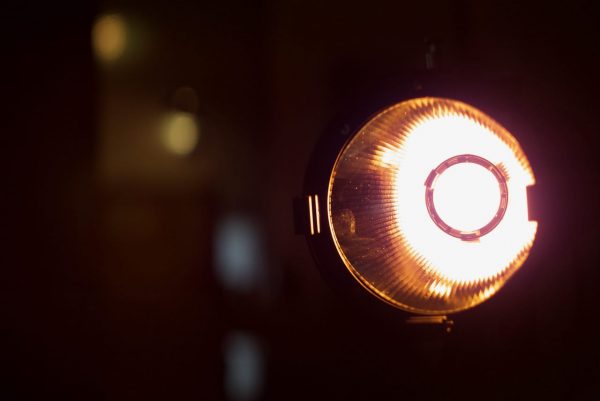
There really isn’t another light on the market that is as versatile at this size, weight and price point. A lot of the features of this light can only be found in more expensive fixtures such as the Arri Skypanel and Digital Sputnik ds-1.
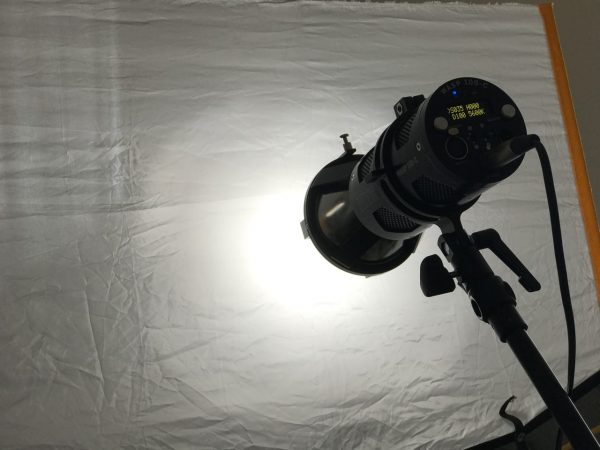
I really enjoyed using the Wasp 100-C. It is easy to use, can be powered off a camera battery, and it will fit in a small bag. I did find that if you wanted to use the light as a soft source you did need to diffuse it heavily. Even if you use diffusion sheets behind the interchangeable HDP lenses the light is still quite harsh. Diffusing it through a soft box or diffusion frame works well as long as you are using the fixture at 5600K and above. If you drop the light’s colour temperature down to 3200K and below the light really doesn’t have enough punch to use through any level of diffusion.
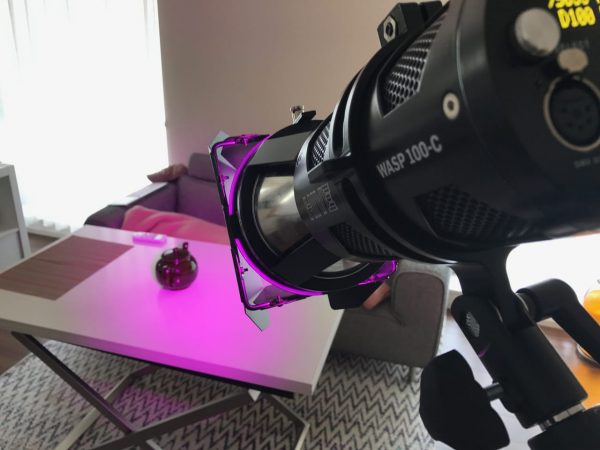
Perhaps the best feature of the light is the ability to change the hue, saturation and colour temperature. This gives you so much added control that you can dial in adjustments depending on what looks best with your camera. At the end of the day a light that replicates a perfect 5600K source with almost perfect colour rendering scores may not end up looking good through your viewfinder or monitor. We don’t live in a perfect world and often it is very subtle adjustments to lights that ends up giving you the best results.
For $999 US the Wasp 100-C delivers a lot of bang for your buck. It’s well made, practical, easy to use and delivers good performance all in a compact package. Hive Lighting have done an excellent job with the Wasp 100-C and come up with a unique light in an already crowded LED market.
WASP 100-C FEATURES
100-240 VAC input via power supply
12 – 28 VDC input via 4-Pin XLR
98 CRI / 97 TLCI
Omni-Color LED (1650K – 8000K)
360 degree Hue controls, 0-100% Saturation
0 – 100% Dimming Control
Manual, DMX, Smartphone Control
5 Lbs
6″ Length x 4″ Diameter body
5″ Reflector face
WASP 100-C KIT INCLUDES:
Wasp 100-C Head Unit with 22° Reflector
Wasp 100-C Power Supply 100-240 VAC
HDP Lenses: Spot, Medium, Wide, and Super Wide
5 inch 4-Leaf Barn Doors
What do you think about the Wasp 100-C? Let us know in the comments section below.




